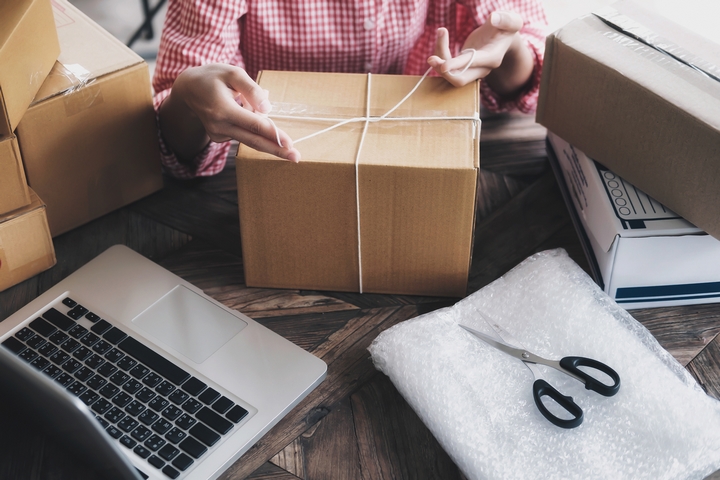
Packaging secures items and prevents potential leakage or breakage. Some food packaging materials prevent the entry of germs or heat, while others prevent moisture entry or the loss of it.
Packaging comes in different forms. Each type is dictated by the mode of shipping and other considerations such as retailing or branding. The packaging material you chose depends on your needs and preference. You should communicate with a packaging company to determine which types of materials best suit your business needs.
Different packaging needs require different packaging materials. Below are the top six types of packaging materials.
Type #1: Paperboard Packaging

This is a paper-based material, which is both strong and lightweight. It’s made from fibrous material or waste paper, which is turned into pulp and bleached.
Paperboard is easy to cut and design into different shapes, sizes, and structures. This makes it the best packaging material for a personalized package. It’s made in different grades depending on the packaging requirements. For instance, solid bleached sulphate (SBS) paperboard is used for items such as cosmetics, milk, medicine, juice, and frozen foods.
Coated unbleached kraft (CUK) paperboard has a natural look and can be used for packaging different retail products. However, it’s lighter than the SBS paperboard, making it unsuitable for packaging frozen items or food-related packages.
Type #2: Plastic Packaging

This is the most commonly used packaging material for a wide range of products. This is because this kind of packaging is durable, and airtight enough to protect the package from contamination. Besides, it can withstand extreme weather conditions. Plastic packaging, however, is the most difficult type of packaging material to dispose of.
There are different types of plastics used in packaging, but the commonly used is Resin. Plastic can be used as a single material or in combination with others. It can be created as a flexible film or rigid container depending on the item being packed. Its flexibility has made it the most popular choice for most industries. Plastic packaging is easy to mould into limitless shapes and styles, and it’s cheap to manufacture.
Rigid plastic containers ensure the safety of the items since they’re impact-resistant. Labelling and decorating plastic packaging is easy compared to other packaging material. It’s easy to showcase an item in a plastic packaging without opening it. It’s ideal for packaging items such as foods, drinks, and eggs.
Type #3: Corrugated Boxes

These are commonly known as cardboards. Corrugated material consists of three layers of paper: an outer and an inner liner with a corrugated medium called fluting, which gives it rigidity and strength. The corrugated board is made from recycled paper sourced from pulp fibre and manufactured on high-precision machinery called a corrugator. Corrugated boards can be recycled repeatedly.
Corrugated boards are single-faced or single, double, or triple walled. The board type determines the strength and durability of the box. These boxes are cut and folded into different shapes and sizes. They are then used to make boxes for packages with different levels of strength, performance, and characteristics.
Most packages are wrapped in foam before being packed in cardboard boxes or sealed tightly to keep them from falling out. The boxes are also used in the retail packaging of small consumer products such as pizzas.
Type #4: Glass Packaging

Glass is made from silica, calcium carbonate, and sodium carbonate. Other compounds are brought in to add sparkle, colour, or resistance to heat shock. It can be sterilized and moulded into various sizes and shapes, such as jars or bottles. It provides a moisture and gas barrier for the package. It’s also pressure-resistant. Because it’s transparent, you can easily see the product without exposing it. Some products require coloured glass since they are degraded by light.
Glass is inert, which implies that it doesn’t contaminate the product. It’s also recyclable, making it ecologically appropriate. The major disadvantage of glass is its fragility, especially when not handled carefully. You can end up with a huge mess and loss of the product.
Glass can be directly decorated or labelled. It’s mainly used for human consumption products such as pickles, jam, honey, medicine, alcoholic beverages, and peppers.
Type #5: Cornstarch Packaging

Cornstarch is an organic material derived from the maize plant. It has plastic-like properties and often used as an alternative to petroleum-based packaging. It can be moulded into different shapes.
The one disadvantage is that it competes with animal and human food supply since it’s derived from maize. This in turn causes the cost of maize (a staple food for humans) to rise.
6. Mushroom Packaging

Mushroom is gaining in popularity as a type of packaging material. It’s commonly used to package small items.
This type of packaging is made from ground agricultural waste, which is joined together by a matrix of mushroom roots called mycelium. The raw material is moulded into different shapes, sizes, and designs. It’s then dried and used as packaging.
Unlike cornstarch packaging, this material is derived from waste, which means it doesn’t use food sources and petroleum. This is good because it doesn’t trigger food shortages and high food prices the way cornstarch does.